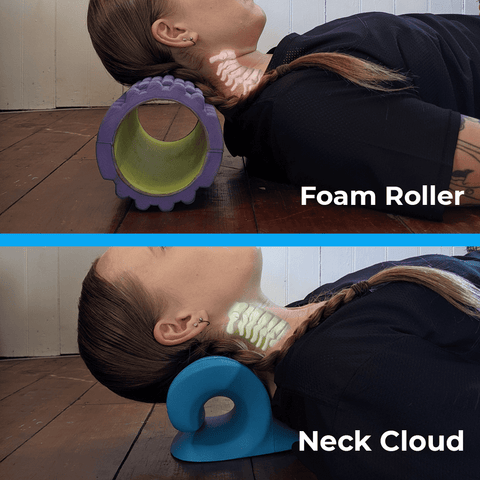Experience the Conveniences of the Neck Cloud for Neck and Shoulder Alleviation
Experience the Conveniences of the Neck Cloud for Neck and Shoulder Alleviation
Blog Article
Neck Discomfort in the Workplace: Identifying Risk Elements and Applying Ergonomic Solutions
Neck discomfort in the office is a widespread concern that can influence worker well-being and performance. By recognizing the various threat elements adding to neck discomfort and carrying out ergonomic options, companies can create a much more helpful work environment. Determining these variables is essential in establishing targeted approaches to minimize discomfort and protect against future injuries. Attending to ergonomic problems not just enhances worker health and wellness yet likewise advertises total task satisfaction and performance.
Typical Root Causes Of Neck Discomfort
Neck discomfort in the work environment is a common problem that can be credited to a number of typical causes. One of the primary offenders is bad position, which commonly arises from long term periods of sitting improperly at a desk or workstation. This can cause stress on the neck muscular tissues and joints, causing pain and discomfort. In addition, repeated movements such as regular flexing, twisting, or reaching can likewise add to neck pain over time. Straining the neck by holding it in an awkward placement for extensive durations, like supporting the phone in between the ear and shoulder, can worsen the concern (neck cloud).

Ergonomic Risk Elements
Poor functional designs in the office can dramatically contribute to neck pain among staff members. Elements such as incorrect desk height, inadequate chair support, and unpleasant positioning of computer system screens can all contribute in the development of neck discomfort. When workers are compelled to sit for extensive periods in placements that strain their neck muscular tissues, it can lead to tightness, soreness, and much more significant musculoskeletal concerns in time.
Furthermore, inadequate ergonomic methods can cause employees taking on awkward positions while functioning, such as craning their necks to see a computer screen or getting to uncomfortably for a mouse or keyboard. neck cloud. These recurring activities and unnatural settings can put excessive anxiety on the neck and bordering muscles, bring about pain and lowered efficiency

Workdesk Configuration Recommendations
When establishing a desk in the workplace, it is necessary to pay attention to the functional designs of the setting. To decrease the risk of neck pain and discomfort, there are a number of workdesk setup recommendations that workers must take into consideration. Firstly, make certain that the computer monitor is positioned at eye level to stop straining the neck by searching for or down. The key-board and computer mouse must be positioned at an elevation where the elbow joints are bent at a 90-degree angle to promote appropriate wrist positioning. Furthermore, the chair height must enable the feet to relax level on the flooring with upper legs alongside the ground.
It is additionally vital to have sufficient lighting to decrease eye pressure, as squinting or leaning forward can result in neck stress. Arrange the desk layout to maintain frequently utilized things within arm's reach, limiting the requirement for repetitive twisting or getting to activities. By implementing these desk configuration suggestions, employees can develop an extra ergonomic work space that sustains neck wellness and lowers the danger of developing occupational neck discomfort.
Stretching and Workout Tips
To keep versatility and blog here decrease muscular tissue stress in the work environment, integrating stretching and workout regimens can be helpful for general well-being and performance. Easy desk-friendly stretches can aid relieve neck pain and protect against tightness. Neck rolls, shoulder shrugs, and mild side-to-side neck stretches are reliable in soothing tension. In addition, incorporating workouts like chin tucks, shoulder blade presses, and upper back stretches can assist strengthen muscle mass that sustain great stance.
Setting reminders or utilizing applications that motivate movement can help develop a normal stretching routine. By prioritizing these tasks, you can improve your physical health, reduce the danger of neck discomfort, and enhance your total productivity in the workplace.
Value of Regular Breaks
In a busy work environment where needs can add to physical strains like neck discomfort, establishing a routine that stresses the value of regular breaks is paramount. By including brief breaks into the job routine, employees can lower the danger of establishing neck discomfort and boost general comfort and performance.
Regular breaks permit workers to rest their muscles, stretch, and alter positions, preventing rigidity and advertising much better flow. Motivating staff members to take brief breaks every 30-60 minutes can aid lower the accumulation of stress in the neck and shoulders. These breaks can likewise act as a possibility for workers to practice leisure methods or mild neck stretches, additionally advertising musculoskeletal wellness. Executing a society that values and prioritizes routine breaks can have a significant effect on decreasing neck discomfort and boosting overall wellness in the office.
Verdict
Finally, addressing ergonomic danger variables and executing correct workstation setups are necessary in reducing neck discomfort in the office. By promoting great stance, providing sufficient support, and motivating normal breaks and stretches, companies can create a healthier and much more efficient work environment for workers. Prioritizing worker health via ergonomic solutions is crucial to stop pain and enhancing total office complete satisfaction.
Neck discomfort in the office is a common problem that can impact worker health and efficiency. By determining and attending to these usual causes of neck pain in the work environment, employers can take positive steps to produce a much more ergonomic and comfortable work setting for their staff members.
Poor functional see page designs in the workplace can considerably contribute to neck discomfort among staff members. By carrying out these desk arrangement suggestions, employees can develop a much more ergonomic workspace that sustains neck health and lowers the danger of have a peek here developing occupational neck pain.
Neck rolls, shoulder shrugs, and mild side-to-side neck stretches are efficient in relieving stress.
Report this page